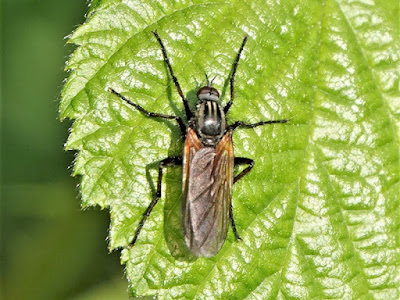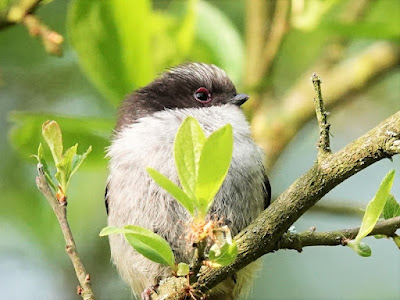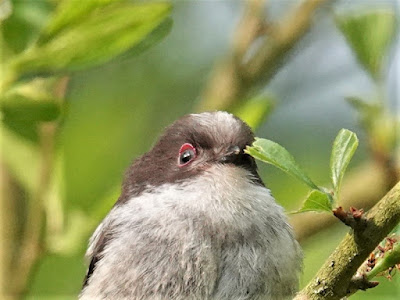Priorslee Balancing Lake and The Flash
8.0°C > 15.0°C: More in the way of high cloud this morning. Still fine and clear. Light north-easterly breeze sprang up after a calm start. Very good visibility.
Sunrise: 05:20 BST
* = a species photographed today.
$ = my first sighting of the species for this year
After tomorrow and now that the Spring passage is about over I am intending to take a few days break from plodding around the lake and The Flash. I will be back!
Priorslee Balancing Lake: 05:15 – 06:20 // 07:40 – 09:30
(119th visit of the year)
Bird notes:
- the pair of Canada Geese still with a single gosling
- the pair of Greylag Geese still with four goslings.
- one or more Mute Swans visited. While inside a wooded area I heard the wing-beats as they flew away and the new resident pen had come off the nest to join the cob, both with wings arched. Whether it was one or two birds I could not say but – see the notes from there – a pair visited The Flash later.
- the pair of Gadwall present early.
- I again saw an unidentified duck hastening in to cover pursued by three (?) small ducklings. She is not 'our' Gadwall which was visible elsewhere at the same time.
- the duck Pochard in her usual place.
- a pair of Tufted Duck is a late date for birds here in Spring.
- *at least two Great Crested Grebe juveniles confirmed on the back of an adult.
- one Common Sandpiper noted at 08:45 but nor previously.
- a Sedge Warbler was singing along the South side. Could it have been here all along? Or is it a tardy new arrival?.
Bird(s) noted flying over here:
- 2 Stock Doves: pair
- 23 Wood Pigeons
- 1 Herring Gull
- 6 Lesser Black-backed Gulls
- 1 Sparrowhawk
- 2 Jackdaws
- no Rooks
- 3 Starlings
Counts from the lake area:
- 8 + 1 (1 brood) Canada Geese
- 2 + 4 (1 brood) Greylag Geese
- 3+ Mute Swans: see notes
- 2 (1♂) Gadwall: see notes
- 6 (5♂) Mallard
- 1 (0♂) + 3? (1 brood) unidentified duck
- 1 (0♂) Pochard as ever
- 2 (♂) Tufted Duck
- 2 Moorhens
- 31 + 5 (2 broods) Coots
- *7 + 2? (1 brood) Great Crested Grebes
- 1 Common Sandpiper
- 1 Herring Gull
Hirundines etc. noted:
None
Warblers recorded (the figure in brackets is birds noted singing):
- 1 (1) Cetti's Warbler
- 15 (14) Chiffchaffs
- 1 (1) Sedge Warbler
- 12 (12) Reed Warblers
- 10 (9) Blackcaps again
- 2 (2) Garden Warblers again
Noted on the West end street lamp poles pre-dawn:
Warblers recorded (the figure in brackets is birds noted singing):
- 1 (1) Cetti's Warbler
- 15 (14) Chiffchaffs
- 1 (1) Sedge Warbler
- 12 (12) Reed Warblers
- 10 (9) Blackcaps again
- 2 (2) Garden Warblers again
Noted on the West end street lamp poles pre-dawn:
Flies:
- 1 plumed midge sp.
Noted later:
- 1 plumed midge sp.
Noted later:
Butterflies:
*Green-veined White Pieris napi
*Green-veined White Pieris napi
Moths
none
none
Bees, wasps etc.:
Common Wasp Paravespula vulgaris
Common Wasp Paravespula vulgaris
Hoverflies:
Cheilosia albitarsus agg. either C. ranunculi [Early Buttercup Cheilosia] or C. albitarsis [Late Buttercup Cheilosia]
Parsley Blacklet Cheilosia pagana
Spring Epistrophe Epistrophe eligans [Spring Smoothtail]
Tapered Dronefly Eristalis pertinax
Tiger Hoverfly Helophilus pendulus
Syrphus sp. S. ribesii / S. vitripennis
Cheilosia albitarsus agg. either C. ranunculi [Early Buttercup Cheilosia] or C. albitarsis [Late Buttercup Cheilosia]
Parsley Blacklet Cheilosia pagana
Spring Epistrophe Epistrophe eligans [Spring Smoothtail]
Tapered Dronefly Eristalis pertinax
Tiger Hoverfly Helophilus pendulus
Syrphus sp. S. ribesii / S. vitripennis
Alder Flies:
Alder Fly Sialis lutaria
Alder Fly Sialis lutaria
Dragon-/Damsel-flies:
Azure Damselfly Coenagrion puella
Azure Damselfly Coenagrion puella
*Common Blue Damselfly Enallagma cyathigerum [Common Bluet]
*$ Blue-tailed Damselfly Ischnura elegans
*$ Blue-tailed Damselfly Ischnura elegans
Other flies
*$ dagger fly Empis tessellata
*Scorpion Fly Panorpa communis (plus other not specifically identified)
*$ marsh fly Tetanocera ferruginea
*Common Crane-fly Tipula oleracea
yet more unidentified flies
*$ dagger fly Empis tessellata
*Scorpion Fly Panorpa communis (plus other not specifically identified)
*$ marsh fly Tetanocera ferruginea
*Common Crane-fly Tipula oleracea
yet more unidentified flies
Bugs:
Red-and-Black Froghopper Cercopis vulnerata
Red-and-Black Froghopper Cercopis vulnerata
Beetles:
Alder Leaf Beetle Agelastica alni
Alder Leaf Beetle Agelastica alni
Spiders, harvestmen etc.:
*Long-jawed Orb-web Spider Tetragnatha sp.
*unidentified spider
*Long-jawed Orb-web Spider Tetragnatha sp.
*unidentified spider
New flowers for the year
None
A different view of the sunrise.
And again, looking "down sun" from the dam top.
There are two heads of juvenile Great Crested Grebes visible on the parent's back here. Maybe more tucked up?
Nothing species just a Pied Wagtail taking the sun.
My first Blue-tailed Damselfly Ischnura elegans damselfly of this year. Other "blue" damselflies have a blue tail but only this species has that combined with an otherwise all-dark abdomen. Note also the pale mark in the wing toward the tip (the pterostigma) that is dark in other species.
Slightly less intimidating from this angle.
The only scorpion fly I bothered to check was this well-positioned Panorpa communis.
Another fearsome looking fly.
It looks slight less fearsome from this angle. It is the marsh fly Tetanocera ferruginea.
And then there were four (legs on this Common Crane-fly Tipula oleracea).
(Ed Wilson)
------------------------------------------------------------------------------------------------------
In the Priorslee Avenue tunnel:
Moths:
*1 Common Swift Korscheltellus lupulina
*1 Common Swift Korscheltellus lupulina
Flies
4 Psychodidae sp. [Drain Fly, Moth Fly or Owl Fly]
31(!) midges of various species.
4 Psychodidae sp. [Drain Fly, Moth Fly or Owl Fly]
31(!) midges of various species.
Spiders, harvestmen etc.:
*1 Garden Spider Araneus diadematus [Garden Cross Spider]
1 unidentified spider
*1 Garden Spider Araneus diadematus [Garden Cross Spider]
1 unidentified spider
A Common Swift moth Korscheltellus lupulina on a wall of the tunnel. I have found singles of this species in each of the last four year, usually in June and usually on the ceiling.
Also in the tunnel against the wall was this Garden Spider Araneus diadematus. It is just possible to see the cross mark at the front of the abdomen that gives rise to its alternative name of Garden Cross Spider. Because it was sitting on a web in front of the wall the flash from the camera created a confusing shadow.
(Ed Wilson)
The Flash: 06:25 – 07:35
(Ed Wilson)
------------------------------------------------------------------------------------------------------
The Flash: 06:25 – 07:35
(116th visit of the year)
Bird notes:
- *a visiting pair of Mute Swans. I never got a good-enough look at the pen to see whether she was ringed. The cob certainly wasn't.
- the brood of five Mallard ducklings appeared to be more than a week old.
- a Great Crested Grebe again.
- a Great Spotted Woodpecker seemed to be ferrying food to a site somewhere alongside squirrel alley.
- *two parties of Long-tailed Tits seen, both with recently-fledged juveniles
Bird(s) noted flying over here:
- 1 Jackdaw
Noted on / around the water:
- 15 Canada Geese
- 1 Greylag Goose
- *3 Mute Swan: a visiting pair. The other resident presumed to be on the island.
- 24 (19♂) + 5 (1 brood) Mallard
- 1 (1♂) all-white feral Aylesbury Duck
- 2 (2♂) Tufted Duck
- 7 Moorhens
- 19 Coots
- *1 Great Crested Grebe
- 1 Herring Gull: immature
Hirundines etc. noted:
- 2 Swifts
- 1 Swallow
Warblers recorded (the figure in brackets is birds noted singing):
- 7 (7) Chiffchaffs
- 5 (5) Blackcaps
Noted around the area:
Moths
*1 Brimstone Moth Opisthograptis luteolata
*1 Brimstone Moth Opisthograptis luteolata
Flies:
numerous different midges
numerous different midges
Mites:
*a tiny (2mm) mite, possibly a Velvet Mite Eutrombidium rostratus.
There were two parties of Long-tailed Tits around the area, both containing recently fledged juveniles. Here is one. Note the very different facial pattern that will only be present for a few weeks.
A Brimstone Moth Opisthograptis luteolata and still not as "crisp" a photograph as I would like. My excuse this time is that it was towards the top of the tallest street lamp pole in the area.
*a tiny (2mm) mite, possibly a Velvet Mite Eutrombidium rostratus.
I think he means business. The resident cob spies a visitor...
And gives chase...
..and again.
They appear. They disappear. They reappear. This Great Crested Grebe was today's reappearing birds.
Another view.
What a sweetie!
I am sure that adults do not have such a pronounced eye-lid.



























